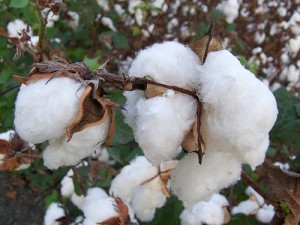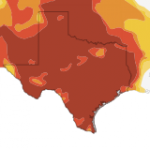What Drought, Cattle and Crimea Have to Do With Texas Cotton Farming

Gary Nored / Flickr/ Creative Commons
The white fruit of the cotton plant is known as the boll. Texas has led the nation in cotton production for over a century.
Every year Texas farmers are faced with a choice: should they focus on growing corn, cotton, or sorghum? Gaylon Morgan has an inkling what kind of year 2014 will be.
“I think we’ll see an increase in cotton, just due to the price difference,” Morgan, a cotton specialist at Texas A&M, tells StateImpact Texas.
It’s simple economics. The prices of grains and corn are down. Farmers want to grow what makes the most money, so they’re planting cotton.
“It’s just supply and demand,” says Morgan.
But if you dig into why corn and grain are down, and cotton up, things get complicated quickly.
John Robinson, a professor in cotton marketing, also at A&M, says there are two main reasons.
One is familiar to Texans: drought.
“If you look at a drought monitor map in the places that are most important for growing cotton and grains, it’s pretty dry there,” Robinson tells StateImpact Texas. “From an economic return standpoint. If you’re going to have a reduced yield due to drought. Cotton is the better crop to have.”
The second reason is the drop in corn and grain.
Robinson says demand for corn to make ethanol has leveled off. The EPA has considered reducing the amount it mandates in US fuel mixes. Even if it doesn’t, better fuel efficiency means there won’t be the same need for it.
While that demand is slowing, corn yields in the Midwest were high last year. And this year, he says “the USDA at least is projecting trend line yields.”“If you pencil it out, with the projected demand we have and the projected supply we have then we’d have more than enough corn,” says Robinson.
Robinson and others also say reduced demand from ranching has taken a toll on corn and grain prices.
Since the great Texas drought of 2001, “livestock has been in decline in the face of drought and high grain prices,” says Mark Welch, an associate professor and extension economist in grain marketing at Texas A&M University.
But, unlike Robinson and Morgan, Welch thinks some farmers might still opt to grow corn and grain this year after all. The reason is the situation in Ukraine.
Turns out the region is known as the bread basket of Europe. The uncertainty there caused by the Russian annexation of Crimea, has stirred up fear of a global shortage of grain and corn. That has started to drive US prices back up again. And that might prompt some farmers to reconsider their options ahead of planting season.
“The story’s not over yet,” says Welch. “I’m thinking we may hang on to some more grain acres we thought we were going to lose … it will be interesting to see how it plays out.”


